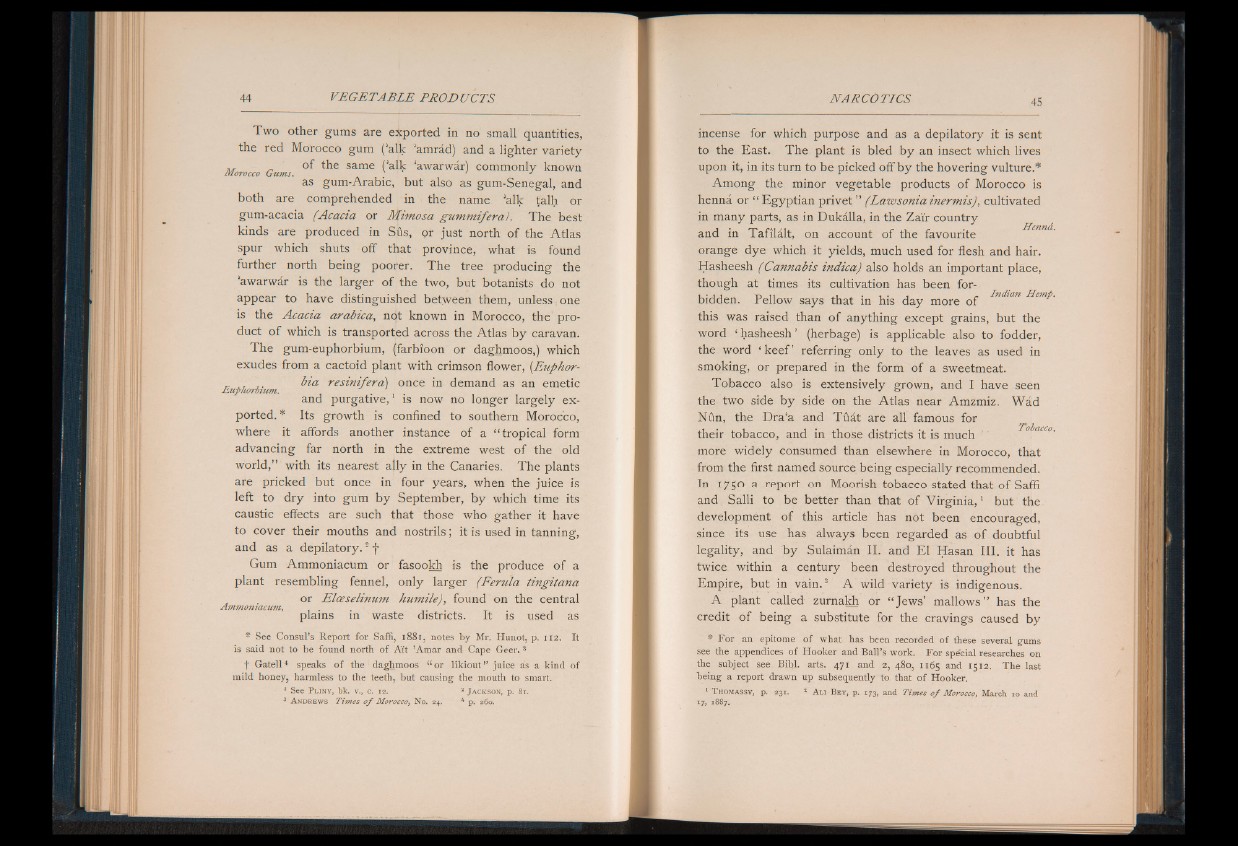
Two other gums are exported in no small quantities,
the red Morocco gum (‘alk ‘amrad) and a lighter variety
Morocco Gums ^ same (>a^ 'awarwar) commonly known
as gum-Arabic, but also as gum-Senegal, and
both are comprehended in the name 'alk talh or
gum-acacia (Acacia or Mimosa gummifera). The best
kinds are produced in Sus, pr just north of the Atlas
spur which shuts off that province, what is found
further north being poorer. The tree producing the
'awarwàr is the larger of the two, but botanists do not
appear to have distinguished between them, unless one
is the Acacia arabica, not known in Morocco, the product
o f which is transported across the Atlas by caravan.
The gum-euphorbium, (farbioon or daghmoos,) which
exudes from a cactoid plant with crimson flower, (Euphor-
r ,, bia resinifera) once in demand as an emetic Jiup fioro turn.
and purgative,1 is now no longer largely exported.
* Its growth is confined to southern Morocco,
where it affords another instance of a “ tropical form
advancing far north in the extreme west of the old
world,” with its nearest ally in the Canaries. The plants
are pricked but once in four years, when the juice is
left to dry into gum by September, by which time its
caustic effects are such that those who gather it have
to cover their mouths and nostrils ; it is used in tanning,
and as a depilatory.2 f
Gum Ammoniacum or fasookh is the produce of a
plant resembling fennel, only larger (Ferula tingitana
or Elceselinum humile), found on the central
Ammomacum, . .
plains in waste districts. It is used as
* See Consul’s Report fo r Saffi, 1881, notes b y Mr. Hunot, p. 112. It
is said not to b e found north o f A it ’Amar and Cape Geer. 3
f G a t e l l4 speaks o f the daghmoos “ or likiou t ” ju ic e as a kind o f
mild honey, harmless to the teeth, but causing the mouth to smart.
1 See P l i n y , bk. v., c. 12. 2 J a c k s o n , p. 81.
3 A n d r e w s Times o f Morocco, No. 24. 4 p . 260.
incense for which purpose and as a depilatory it is sent
to the East. The plant is bled by an insect which lives
upon it, in its turn to be picked off" by the hovering vulture.*
Among the minor vegetable products of Morocco is
henna or “ Egyptian privet ” (Lawsonia inermis), cultivated
in many parts, as in Dukalla, in the Zair country
and in Tafilalt, on account of the favourite
orange dye which it yields, much used for flesh and hair.
Hasheesh (Cannabis indica) also holds an important place,
though at times its cultivation has been forbidden.
Pellow says that in his day more of Indmn Heml-
this was raised than o f anything except grains, but the
word ‘ hasheesh ’ (herbage) is applicable also to fodder,
the word ‘ k e e f’ referring only to the leaves as used in
smoking, or prepared in the form of a sweetmeat.
Tobacco also is extensively grown, and I have seen
the two side by side on the Atlas near Amzmiz. Wad
Nun, the Dra'a and Tuat are all famous for
their tobacco, and in those districts it is much
more widely consumed than elsewhere in Morocco, that
from the first named source being especially recommended.
In 1750 a report on Moorish tobacco stated that o f Saffi
and Salli to be better than that of Virginia,1 but the
development of this article has not been encouraged,
since its use has always been regarded as o f doubtful
legality, and by Sulaiman II. and El Hasan III. it has
twice within a century been destroyed throughout the
Empire, but in vain.2 A wild variety is indigenous.
A plant called zurnakh or “ Jews’ mallows” has the
credit o f being a substitute for the cravings caused by
* For an epitome of what has been recorded of these several gums
see the appendices of Hooker and Ball’s work. For spe'cial researches on
the subject see Bit)l. arts. 471 and 2, 480, 1165 and 1512. The last
being a report drawn up subsequently to that of Hooker.
1 T h om a s s y , p. 23 1 . 2 A l i B e y , p. 1 73 , and Times o f Morocco, March 10 and
17, 1887.